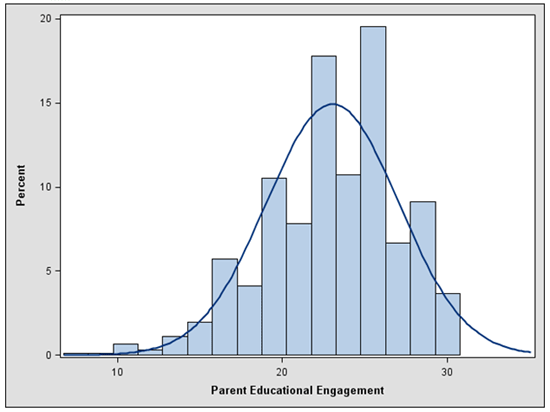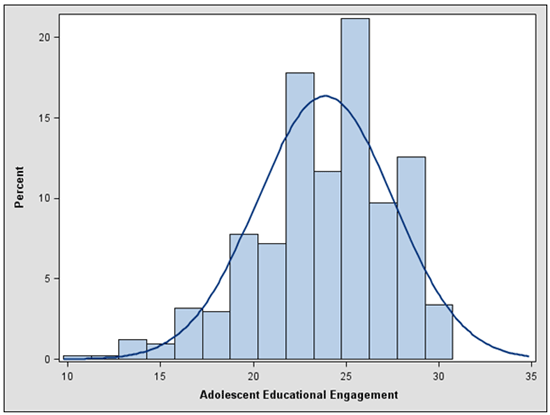Educational Engagement
Definition
Researchers have described educational engagement as encompassing three areas: behavioral engagement, emotional engagement, and cognitive engagement.
-
Behavioral engagement is defined as including participation in school related activities, involvement in academic and learning tasks, positive conduct, and the absence of disruptive behaviors.
-
Emotional engagement includes caring about doing well, being energized by the subject matter, and feeling that one’s identity as a student is central .
-
Cognitive engagement involves curiosity and an investment of time and energy in learning, and a willingness to go beyond the basic requirements to master difficult skills.
Parent Scale
How often does your child… (None of the time, A little of the time, Some of the time, Most of the time, All of the time)
-
care about doing well in school?
-
pay attention in class?
-
go to class unprepared?
Please indicate how much you agree or disagree (Strongly agree, Somewhat agree, Neither agree nor disagree, Somewhat disagree, Strongly disagree)
-
If something interests my child, he/she tries to learn more about it.
-
My child thinks the things he/she learns at school are useful.
-
My child believes that being a student is one of the most important parts of who he/she is.
Parent Scale Psychometric Properties and Fit Indices
We conducted confirmatory factor analysis (CFA) to examine whether responses to the scale appeared to measure a single construct. Along with Cronbach’s alpha, we present model fit indices below.

-
Alpha=0.80 (excellent)
-
CFI=0.999 (excellent)
-
TLI=0.998 (excellent)
-
RMSEA=0.026 (excellent)
Adolescent Scale
Please indicate how often this has happened this school year. How often do you… (None of the time, A little of the time, Some of the time, Most of the time, All of the time).
-
care about doing well in school?
-
pay attention in class?
-
go to class unprepared?
Please indicate how much you agree or disagree (Strongly agree, Somewhat agree, Neither agree nor disagree, Somewhat disagree, Strongly disagree)
-
If something interests me, I try to learn more about it.
-
I think the things I learn at school are useful.
-
Being a student is one of the most important parts of who I am.
Adolescent Scale Psychometric Properties and Fit Indices

-
Alpha=0.72 (good)
-
CFI=0.996 (excellent)
-
TLI=0.990 (excellent)
-
RMSEA=0.043 (excellent)
Subgroup Model Fit
We tested the final adolescent and parent models with subgroups to examine whether the model fit for different subsets of respondents in the same manner as the overall sample. Using the same fit statistic requirements as the overall models, a check mark indicates that the model fit for the subgroup. Due to relatively small sample sizes and sparse categorical responses, resulting in too many bivariate empty cells, we were not able to fit all of the models. The subgroups for which we were not able to fit a model are indicated with N/A. Household income is defined as “low” if it is less than the median income in the sample. “High” household income indicates that the household income was equal to or greater than the sample’s median.

Concurrent Validity
Four single item measures were used to examine the concurrent validity of the adolescent scale: a measure of social behavior (fighting), a measure of health behavior (smoking), a measure of emotional health (adolescent-reported depressive symptoms), and a measure of cognitive development (grades).
Concurrent validity was examined in two ways: with bivariate and multivariate analyses. The table below presents the results of multivariate analyses, which control for: teen gender, teen age, teen race, household income, household size, parental education, parental marital status, parental home ownership, parental employment, and metropolitan area and region of residence. The beta coefficient of the relationship between the construct’s scale and outcome is presented.

The graphs below show the bivariate relationships between the adolescent scale and outcomes. Results are presented for relationships that were at least moderately significant (at the 0.10 level) in the multivariate analyses. Note that the y axis scales are different in each graph.

© Copyright 2024 ChildTrendsPrivacy Statement
Newsletter SignupLinkedInThreadsYouTube